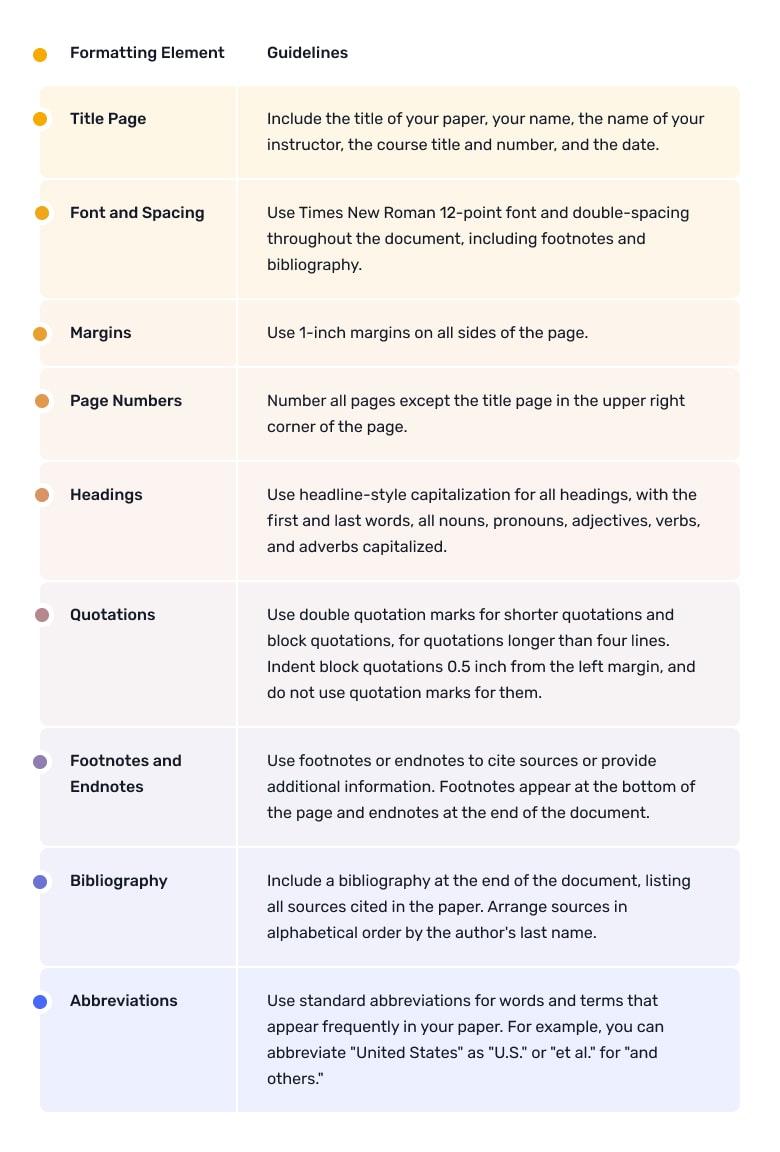Chicago Style
Chicago style is a widely used citation style in academic writing. It is commonly used in history, social sciences, and some humanities fields. Here’s a step-by-step guide on how to write a paper in Chicago style.
1. Choose your topic and research it thoroughly
Before you begin writing, make sure you have a clear understanding of your topic. Research your topic thoroughly using academic sources such as books, journal articles, and reputable websites.
2. Create an outline
Once you have a good understanding of your topic, create an outline of your paper. This will help you organize your thoughts and ensure that your paper is well-structured.
3. Write your paper
Follow your outline and write your paper. Make sure to use clear and concise language and to support your arguments with evidence from your research.
4. Use footnotes or endnotes to cite your sources
In Chicago style, you must use footnotes or endnotes to cite your sources. These should be numbered consecutively throughout your paper.
5. Include a bibliography
At the end of your paper, include a bibliography that lists all the sources you used in your research. These should be listed in alphabetical order by the author’s last name.
6. Use the proper formatting
In Chicago style, the paper should be double-spaced with one-inch margins on all sides. Use Times New Roman or a similar font in 12-point size.
7. Proofread your paper
Once you’ve finished writing your paper, proofread it carefully for errors in grammar, spelling, and punctuation. Make sure that your citations are accurate and consistent throughout your paper.
8. Submit your paper
Once you’ve proofread your paper, you’re ready to submit it. Make sure to follow any specific guidelines given by your instructor or department for formatting and submission.
Remember, the key to writing a successful paper in Chicago style is to do thorough research, organize your thoughts, and use proper citations. By following these steps, you can write a paper that is clear, concise, and well-supported by evidence from your research.
General Guidelines

Referencing Guidelines
Chicago is also an author-date style of citing sources, though it uses a different approach than APA. A parenthetical citation in the Chicago format typically contains the author’s last name, the year of publication, and the page number from which the data was taken (for direct quotes).
Here are some examples of how in-text citations can be formatted in Chicago.
ONE AUTHOR
Elliot (2005, 23) was the first to indicate the positives of school uniforms.
School uniforms’ benefits for modern schools were first highlighted in 2005 (Elliott 2005, 23).
TWO AUTHORS
Magnus and Ronald (2005, 10) noted that gastrointestinal problems are still frequently misdiagnosed.
Gastrointestinal problems are still frequently misdiagnosed (Magnus and Ronald 2005, 10).
THREE AND MORE AUTHORS
If three or more authors wrote your source, you can indicate only the first author’s last name and use et al., like in the example below:
The theory of relativity turned modern physics upside down (Meadows et al. 2020, 345).
Meadows et al. (2020, 345) noted that the theory of relativity turned modern physics upside down.
Citations formatted in the Chicago style should look as follows on the reference page:
BOOK
Johnson, Alex. 2020. Citing Sources in Chicago Style. Princeton: Princeton University Press.
ARTICLE
Karol, Nancy. 2018. “How to Use Chicago Correctly?” Journal of Modern Languages 25, no. 2: 155-160.
WEB RESOURCE
Wikipedia. n.d. “Chicago referencing.” Accessed on September 2, 2022. https://en.wikipedia.org/The_Chicago_Manual_of_Style
How to Cite Sources
Notes and Bibliography (NB)

Author-Date (AD)

Extra Tips
Please note the following nuances of the Chicago style’s use:
- There is no ampersand use in parenthetical citations of sources with two authors.
- There is no comma between the author’s last name and the year of publication.
- Chicago may follow an author-date or endnote/bibliography style of citing sources, so you need to specify the nuances with your professor.
- Indicate DOIs and URLs for journals and peer-reviewed publications.
Whenever you have trouble with Chicago referencing, don’t hesitate to use our handy Chicago citation generator. It will help you bring all citations to order and make the paper consistent.